Oliver Brock, Ph.D.
Research Associate and Scientific
Consultant
Robotics Laboratory
Computer Science Department
Stanford University
Gates Building 1A, Room 122
353 Serra Mall #146
Stanford, CA 94305-9010
|
fon (650) 725-8810
fax (650) 725-1449
|

|
My new web page is at the University of Massachusetts Amherst.
What's on this page?
Short Bio
Currently I am working with my former advisor Oussama Khatib on
various aspects of elastic planning for robots with many degrees of
freedom, such as humanoid robots.
Previously, I was a lecturer and research scientist at Rice University with Professor Lydia Kavraki in the Physical
Computing Group. Spring 2000 I taught COMP430: Introduction to
Databases; Fall 2000 I was supposed to teach COMP584:
Computational Geometry, but unfortunately I had to leave Rice
to fulfill other commitments back in California.
I also was a Ph.D. student at the Robotics Lab in the Computer Science department at
Stanford University; my advisor
was Professor Oussama
Khatib.
I started out at the Technical
University Berlin studying Computer Science. I wrote my master
thesis in robotics in the group
of Professor
Günter Hommel.
back to the top
Research Interests
Currently, mobile robots and mobile manipulators often perform poorly
in unknown, unstructured, and dynamic environments. By integrating
motion planning and motion execution I attempt to design motion
generation algorithms that combine the best of both worlds: they are
immune to local minima and guaranteed to reach the goal if possible,
like planning algorithms, and achieve reactive real-time obstacle
avoidance, like most execution paradigms. The results of this work are
the global dynamic window approach and the elastic strip framework
(see publications below).
I also have been working with Lydia Kavraki on decomposition-based
planning, which can be viewed as a continuation of my work on
Elastic Strips and promises to be a very powerful motion planning and
motion generation approach with many applications in robotics and
beyond.
Other research interests include motion planning and its applications
to areas like computational molecular biology, character animation,
virtual prototyping; also collision avoidance,
mobile manipulation, mobile robotics, and computational geometry.
back to the top
Introduction to my Research
back to the top
Recent Results
Task-Consistent Obstacle Avoidance and Motion Behavior
The elastic
strip approach is an approach to real-time replanning and motion
execution in dynamic environments for robots with many degrees of
freedom. It allows the integration of various motion behaviors. For
example, the end effector can execute a task, while the redundant
degrees of freedom are used for obstacle avoidance. Below are three
videos, which resulted from work together with Sriram Viji: on the left the
elastic strip is used to avoid obstacles, but the task is not
maintained. The video in the middle shows how task execution and
obstacle avoidance can be integrated. The task is to follow the red
line with the end effector. Watch how in the first video the end
effector deviates significantly from the task so that the obstacles
can be avoided. In the second video the end effector does not deviate
at all, despite the fact that the obstacles perform the same motion as
in the first video.
Sometimes constraints can make it impossible to perform the task. In
the case of the third video, the end effector has to deviate from the
task to avoid the second Scout robot. The framework allows task
suspension and automatic task resumption; watch closely, how the end
effector deviates from the line and after passing the obstacle resumes
the task.
Click on the images to see the movies.
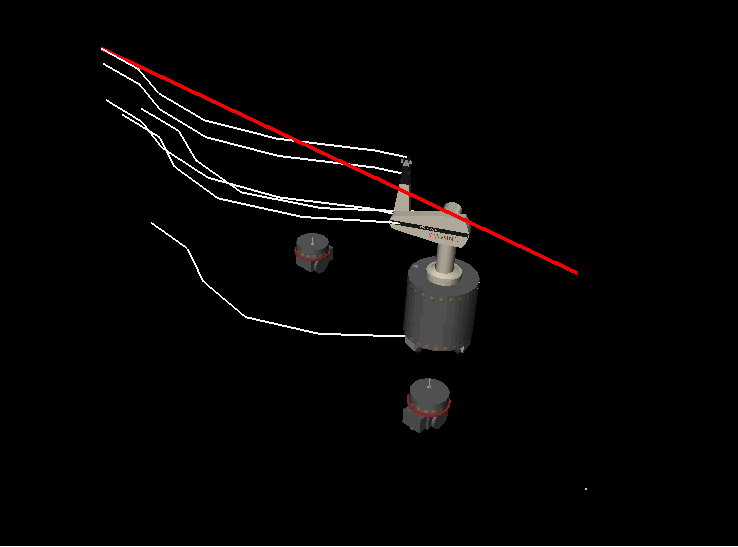 (3MB)
(3MB)
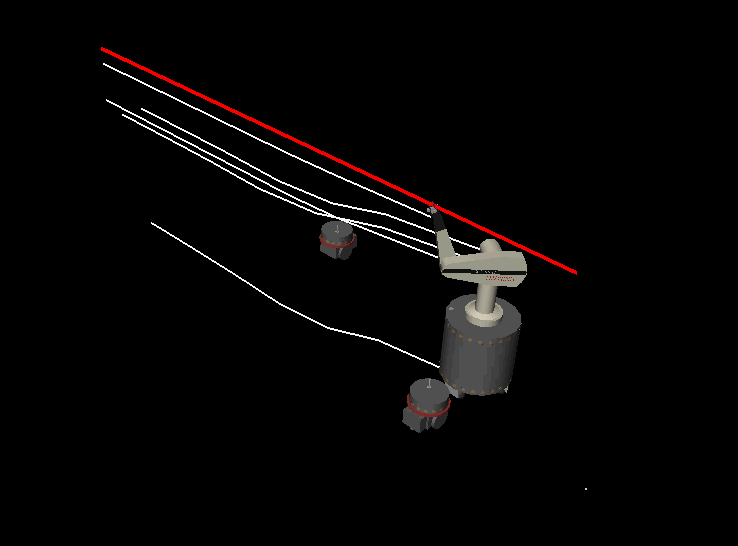 (3MB)
(3MB)
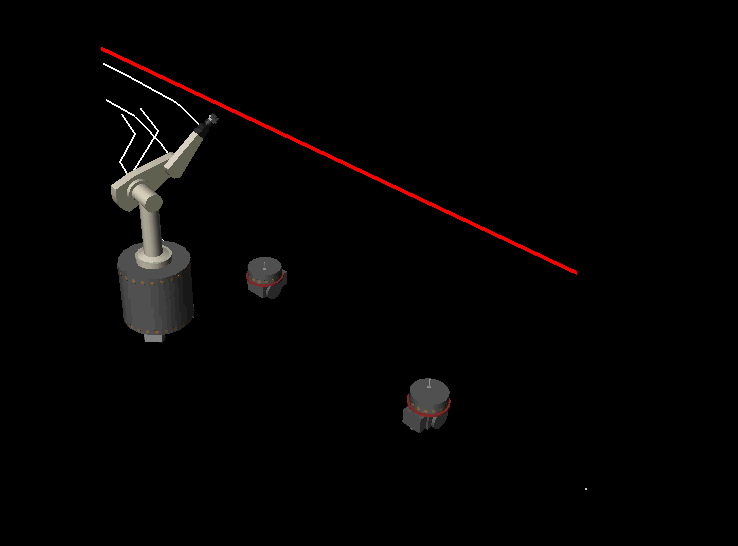 (3MB)
(3MB)
You can also check out our video submission to ICRA 2002:
Task-Consistent Obstacle Avoidance for Mobile Manipulation (23MB)
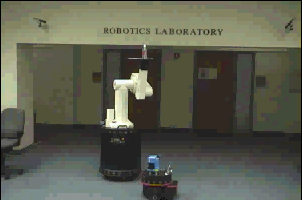 (23MB)
(23MB)
Real-Time Obstacle Avoidance and Posture Control for Humanoid
Robots
In these two videos you see the elastic strip approach applied to a
humanoid robot with more than 30 degrees of freedom. This is a fairly
complicated environment, in which one of the office chairs moves into
the path of the robot and the upper beam of the door is lowered during
the motion. The left video shows how the robot moves without posture
control. The video on the right shows the same motion when a very
simple posture behavior is imposed. It does not look perfectly human
yet, but it serves well to illustrate the idea and the ease with which
such posture can be integrated in the elastic strip framework. In the
future, we will work on postures based on balance constraints and so
on...
Click on the images to see the movies.
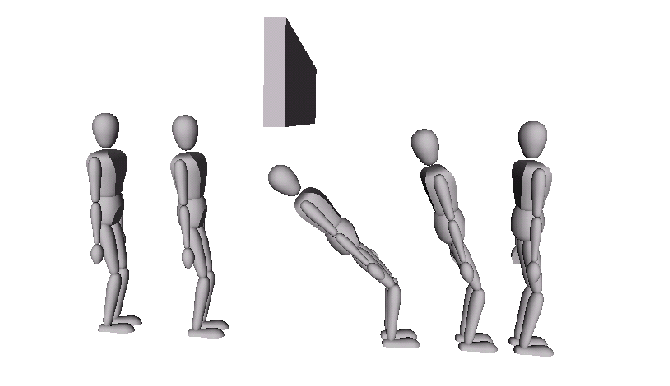 without posture (1MB)
without posture (1MB)
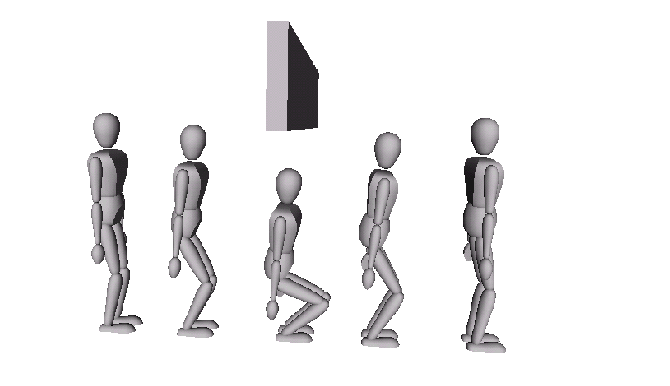 with posture (1MB)
with posture (1MB)
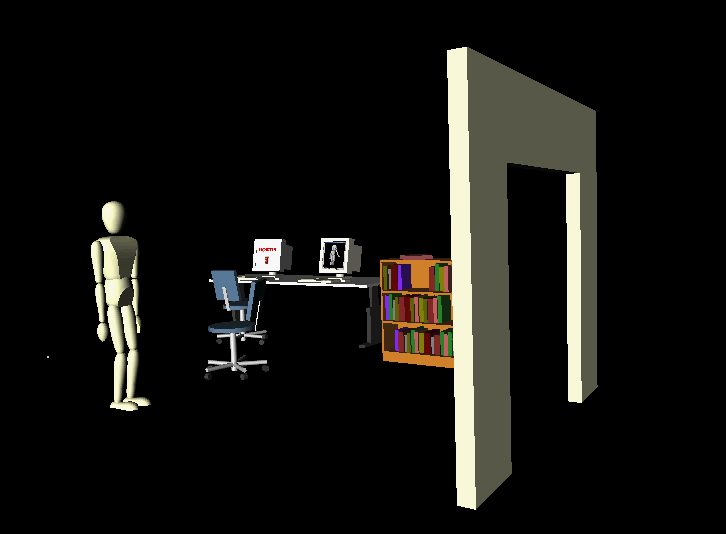 without posture (6MB)
without posture (6MB)
 with posture (6MB)
with posture (6MB)
And here is another (slightly humorous) video, showing a humanoid
robot skiing. The serious point here is to show how all degrees of
freedom are used in real time to avoid obstacles. Watch how the
snowman moves into the path and how the finish sign is sliding down
the poles. Note how the ski poles move to avoid the snowman and to
fit through the finish gate; note also how the whole posture of the
robot changes to pass under the finish sign.
Click on the image to see the movie.
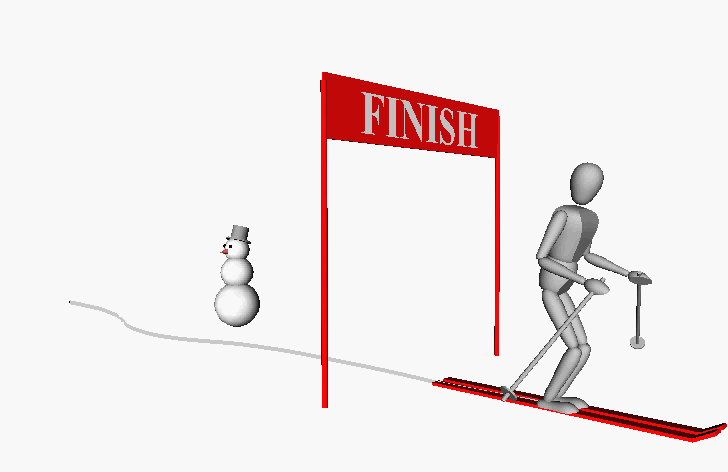 (5MB)
(5MB)
Looking at this video you can imagine how these methods find direct
applicability in character animation for movies or video games. The
motion of characters can be specified independently of other
characters or objects in the scene, and independently of the number of
degrees of freedom at the task level. This allows for more realistic
games with higher interactivity for smaller production costs.
Local Replanning
And I finally got around to creating a video answering the most
frequently asked question: What happens when an obstacle crosses the
path and continues to move? How does the elastic strip appraoch
deal with that?
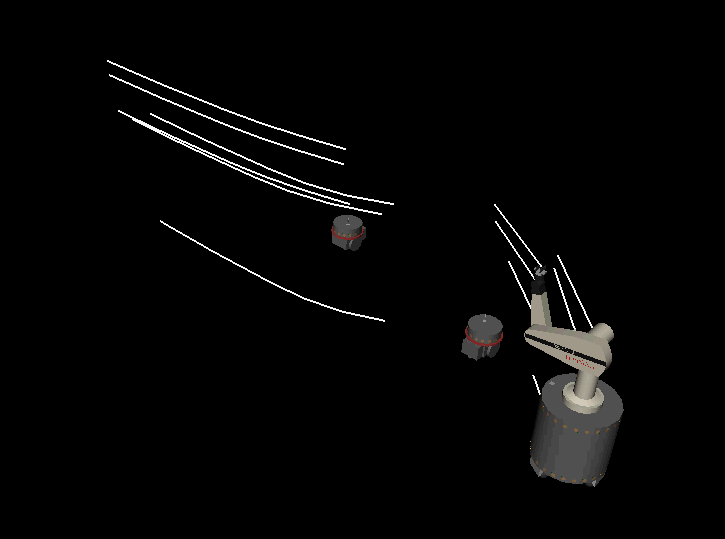 (3MB)
(3MB)
back to the top
Publications
- Khatib, Oussama, Oliver Brock, Kyong-Sok Chang, Francois Conti,
Diego Ruspini, and Luis Sentis.
Robotics and Interactive Simulation.
To appear in Communications of the ACM.
available as:
Postscript (3.9MB) or
PDF (1.4MB)
- Brock, Oliver, Oussama Khatib, and Sriram Viji.
Task-Consistent
Obstacle Avoidance and Motion Behavior for Mobile Manipulation.
To appear in IEEE International Conference on Robotics and
Automation 2002, 2002.
available as:
Postscript (3.9MB) or
PDF (1.4MB)
- Brock, Oliver, Oussama Khatib, and Sriram Viji.
Task-Consistent Obstacle Avoidance for Mobile Manipulation.
Submitted to Video Proceedings of
the 2002 International Conference on Robotics and
Automation.
Download the video. (23MB)
- Khatib, Oussama, Oliver Brock, Kyong-Sok Chang, Diego Ruspini,
Luis Sentis, and Sriram Viji. Human-Centered Robotics and
Interactive Haptic Simulation. To appear in Robotics
Research, Springer Verlag, 2002.
available as:
Postscript (10MB) or
PDF (1.5KB)
- Khatib Oussama, Kazu Yokoi, Oliver Brock, Kyong-Sok Chang, and
Arancha Casal. Robots in Human Environments.
Archives of Control Sciences, Special Issue
on Granular Computing. Volume 11 (XLVII), 2001, No. 3-4,
pages 123-128.
available as:
Postscript (7.8MB, invited reprint of earlier paper)
PDF (2MB)
- Brock, Oliver and Lydia E. Kavraki. Decomposition-based Motion
Planning: A Framework for Real-time Motion Planning in
High-dimensional Configuration Spaces.
In IEEE International Conference on Robotics
and Automation 2001.
available as:
Postscript (1.8MB) or
PDF (450KB)
- Brock, Oliver and Lydia E. Kavraki. Towards Real-time Motion
Planning in High-dimensional Spaces. In
Proceedings of the International Symposium on Robotics and
Automation 2000.
available as:
Postscript (1.8MB) or
PDF (500KB)
- Brock, Oliver and Lydia E. Kavraki. Decomposition-based Motion
Planning: Towards Real-time Planning for Robots with Many
Degrees of Freedom. Technical Report TR00-367, Rice University,
August 2000.
available as:
Postscript (2.5MB) or
PDF (600KB)
- Brock, Oliver and Oussama Khatib. Integrated Planning and
Execution: Elastic Strips. Proceedings of the 2000 World
Automation Congress.
available as:
PDF (1.4MB)
- Brock, Oliver and Oussama Khatib. Real-Time Replanning in
High-Dimensional Configuration Spaces Using Sets of Homotopic
Paths. Proceedings of the 2000 IEEE
International Conference on Robotics and Automation.
available as:
Postscript (1.1MB) or
PDF (300KB)
- Brock, Oliver and Oussama Khatib. High-Speed Navigation Using
the Global Dynamic Window Approach. Video Proceedings of
the 2000 International Conference on Robotics and
Automation.
Download the video. (30MB)
- Brock, Oliver. Generation of Robot Motion: Integrating
Planning and Execution. Ph.D. Thesis. Stanford
University. November 1999.
available as:
Postscript (15MB) or
PDF (3.7MB)
- Khatib, Oussama, Kazu Yokoi, Oliver Brock, Kyong-Sok Chang,
and
Arancha Casal. Robots in Human Environments: Basic Autonomous
Capabilities. International Journal of
Robotics Research. July 1999. vol.18, no.7, p. 684-96.
available as: PDF
(3.2MB)
- Khatib Oussama, Kazu Yokoi, Oliver Brock, Kyong-Sok Chang, and
Arancha Casal. Robots in Human Environments.
Proceedings of the First Workshop on Robot Motion and
Control.
June 1999. p. 213-221.
- Brock, Oliver and Oussama Khatib. Real-Time Obstacle Avoidance
and Motion Coordination in a Multi-Robot Workcell.
Proceedings of the
1999 International Symposium on Assembly and Task
Planning. July 1999.
available as:
Postscript (4MB) or
PDF
(270KB).
- Brock, Oliver and Oussama Khatib. High-Speed Navigation Using
the Global Dynamic Window Approach. Proceedings of the 1999
IEEE International
Conference on Robotics and Automation
available as:
Postscript (1MB) or
PDF (260KB). Or download a
video. No, the video is NOT sped up!!! (30MB)
- Khatib, Oussama, Oliver Brock, et al. Dancing with
Juliet. Video Proceedings of the 1999 International
Conference on Robotics and Automation.
- Brock, Oliver and Oussama Khatib. Elastic Strips: A Framework
for Integrated Planning and Execution. Proceedings of the
1999 International Symposium on Experimental Robotics.
Preprints, pages 245-54.
available as:
Postscript (2.5MB) or
PDF (109KB)
- Brock, Oliver and Oussama Khatib. Executing Motion Plans for
Robots with Many Degrees of Freedom in Dynamic
Environments. Proceedings of the 1998 IEEE International
Conference on Robotics and Automation, Volume
1, pages 1-6, 1998.
available as:
Postscript (6MB) or
PDF (480KB)
- Brock, Oliver and Oussama Khatib. Mobile Manipulation:
Collision-Free Path Modification and Motion
Coordination. Proceedings of the 2nd International
Conference
on Computational Engineering in Systems Applications,
Volume
4, pages 839-845, 1998.
available as:
Postscript (4.7MB) or
PDF (300KB)
- Brock, Oliver and Oussama Khatib. Elastic Strips: Real-Time
Path
Modification for Mobile Manipulation. In
Robotics Research, pages 5-13, Springer Verlag, 1998.
available as:
Postscript (4.8MB) or
PDF (340KB)
- Brock, Oliver. Evolving Reusable Subroutines for Genetic
Programming. In
John R. Koza, editor, Artificial Life at Stanford 1994
,
pages 11-19. Stanford Bookstore, Stanford, California,
94305-3079, USA, June 1994.
back to the top
Video Proceedings
- Brock, Oliver, Oussama Khatib, and Sriram Viji.
Task-Consistent Obstacle Avoidance for Mobile Manipulation.
Submitted to Video Proceedings of
the 2002 International Conference on Robotics and
Automation.
Download the video. (23MB)
- Brock, Oliver and Oussama Khatib. High-Speed Navigation Using
the Global Dynamic Window Approach. Video Proceedings of
the 2000 International Conference on Robotics and
Automation.
Download the video. (30MB)
- Khatib, Oussama, Oliver Brock, et al. Dancing with
Juliet. Video Proceedings of the 1999 International
Conference on Robotics and Automation.
back to the top
Theses
- Brock, Oliver. Generation of Robot Motion: Integrating
Planning and Execution. Ph.D. Thesis,
Stanford Univserity. 1999.
available as:
Postscript (15MB) or
PDF (3.7MB)
- Brock, Oliver. InterPlan - ein interaktives
Planungssystem (InterPlan - an Interactive Task Planning
System). Masters Thesis (Diplomarbeit).
Technical University of Berlin, 1993.
- Brock, Oliver. Die Berechnunskraft von synchronisierten
alternierenden Automaten, insbesondere in Abhängigkeit
der
Zahl der Prozesse (The Computational Power of Synchronized
Alternating Automata - In Particular with Respect to the
Number
of Processes). Honors Thesis (Studienarbeit).
Technical University of Berlin, 1993.
back to the top
Miscellaneous
back to the top
My new page at UMass Amherst.
 Stanford
Stanford
 CS Department
CS Department
 Robotics Lab
Robotics Lab
 Manipulation
Lab
Manipulation
Lab
Last modified on February 1, 2002 by Oliver Brock


 without posture (1MB)
without posture (1MB)
 with posture (1MB)
with posture (1MB)
 without posture (6MB)
without posture (6MB)
 with posture (6MB)
with posture (6MB)
![]() Stanford
Stanford
![]() CS Department
CS Department
![]() Robotics Lab
Robotics Lab
![]() Manipulation
Lab
Manipulation
Lab